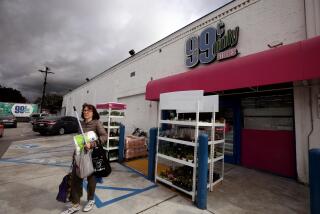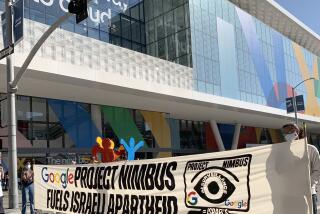California’s jobless rate is peaking, experts say
California’s jobless rate is close to peaking, but the recovery will be sluggish, with employers not expected to resume hiring until at least next spring, according to new forecasts by UCLA and other analysts.
The state’s unemployment rate, which hit 12.5% in October, will probably peak at 12.7% this month. Still, it won’t fall below 10% until 2012, according to a UCLA Anderson forecast released today.
That means California’s economy almost certainly will continue to struggle for the foreseeable future. And key industries such as housing and manufacturing probably won’t return to pre-recession levels of employment for years, according to UCLA and forecasts this month from Chapman University in Orange, Beacon Economics and Comerica Bank.
“There are encouraging signs that the labor market is healing, but there’s going to be more damage,” said Jerry Nickelsburg, a senior economist at the UCLA Anderson Forecast.
UCLA economists predict that California will start adding jobs in 2010, but that the state’s economy won’t start growing significantly until 2011. That view is largely shared by Esmael Adibi, director of the A. Gary Anderson Center for Economic Research at Chapman.
“Recovery is going to continue,” Adibi said. “Having said that, it’s going to be anemic by historical standards.”
Economies tend to rebound from deep recessions quickly, with the output of goods and services shooting up robustly, producing what looks like a V-shaped fall and rise. But this recovery is expected to be slower and less robust.
Consumer demand in the U.S. and abroad will be key to California’s recovery, Nickelsburg said. When shoppers start spending again, factories in the state will start producing more goods to fill orders, farmers will have more customers for their agricultural products, and Southern California’s logistics and shipping industry will ramp up to move those goods.
But other key sectors, such as government and housing, still have a way to go.
Hundreds of thousands of state workers are still furloughed three days a month, a situation that’s likely to continue for some time.
In addition, state lawmakers have put off some budget cuts until the next fiscal year, portending more government layoffs ahead, Nickelsburg said.
Although residential construction may begin to tick up next year, high vacancy rates in commercial buildings lead economists to believe that activity in that sector will continue to decline in 2010.
The recovery could alter the employment landscape in Southern California, much as the recovery after the 1991 recession was marked by a permanent decline in the once-crucial aerospace industry.
This time, “there’s going to be a transformation away from retail and residential construction and toward healthcare, education and jobs associated with renewable energy,” Nickelsburg said. “If one is coming out of an area such as construction, it might be wise to look at alternative sectors for the next job.”
That means people such as Juan Genis, a 56-year-old stonemason, may do well to start thinking about another line of work. Genis, who lives in Lake Elsinore, hasn’t found one day of employment in two months, he said, the worst he’s seen in his 30-year career.
He’s looked in San Diego and North Hills for work. He called a friend in Colorado to see whether there were any jobs for him there. So far he’s come up empty.
Still, he said the idea of changing careers or going back to school is virtually impossible for him with a wife and three kids to support.
“Right now, I’m too old to start another business,” he said. “I take care of my family all by myself. I don’t have a chance to learn another skill.”
Others like Genis who don’t see any improvement in the labor market might find it tough to believe a recovery is imminent. Surveys indicate there are a lot of pessimists out there. About 38% of Americans believe the economy is getting better, while 58% think it’s getting worse, according to a Gallup economic report released Tuesday. The report also indicates that consumer spending last week was down 21% from a year earlier.
Spending might slow down again, said Los Angeles economist Christopher Thornberg, a principal at Beacon Economics, which also released an economic forecast Tuesday.
Tax credits and rebates included in the federal stimulus bill are freeing up Americans’ income, Thornberg said, motivating many to spend rather than save. If those tax breaks are rolled back, as scheduled, at the end of next year, consumers will be forced to curtail spending, he said, dealing a major setback to the recovery.
“Over the next couple of years, as consumers are hamstrung by low savings, you have weak consumer spending and the recovery comes out as mediocre,” he said.
Economists at Beacon expect to see “sustained” job growth in the state in the second quarter of 2010. The unemployment rate will peak this year at 12.4%, they said, and it will remain around 10% for two years. Home prices have bottomed and probably won’t inflate wildly again as they did during the real estate bubble.
Although California was hit harder than the rest of the nation because of its dependence on trade and tourism, the nation’s rebound will help the state, Thornberg said.
The innovative bent of California entrepreneurs also will help power the state’s recovery, said Dana Johnson, senior vice president and chief economist at Comerica Bank. Comerica on Tuesday released its monthly California economic activity index, which held steady in October after increasing for six consecutive months.
Healthcare and high-tech companies are already generating new jobs, Johnson said, and demand from outside California will help the state’s recovery. That means that although Californians may be feeling pain now, it will subside eventually.
“It’s very clear to me that a national and global recovery is underway,” he said. “As a result, the environment in California will continue to improve.”







